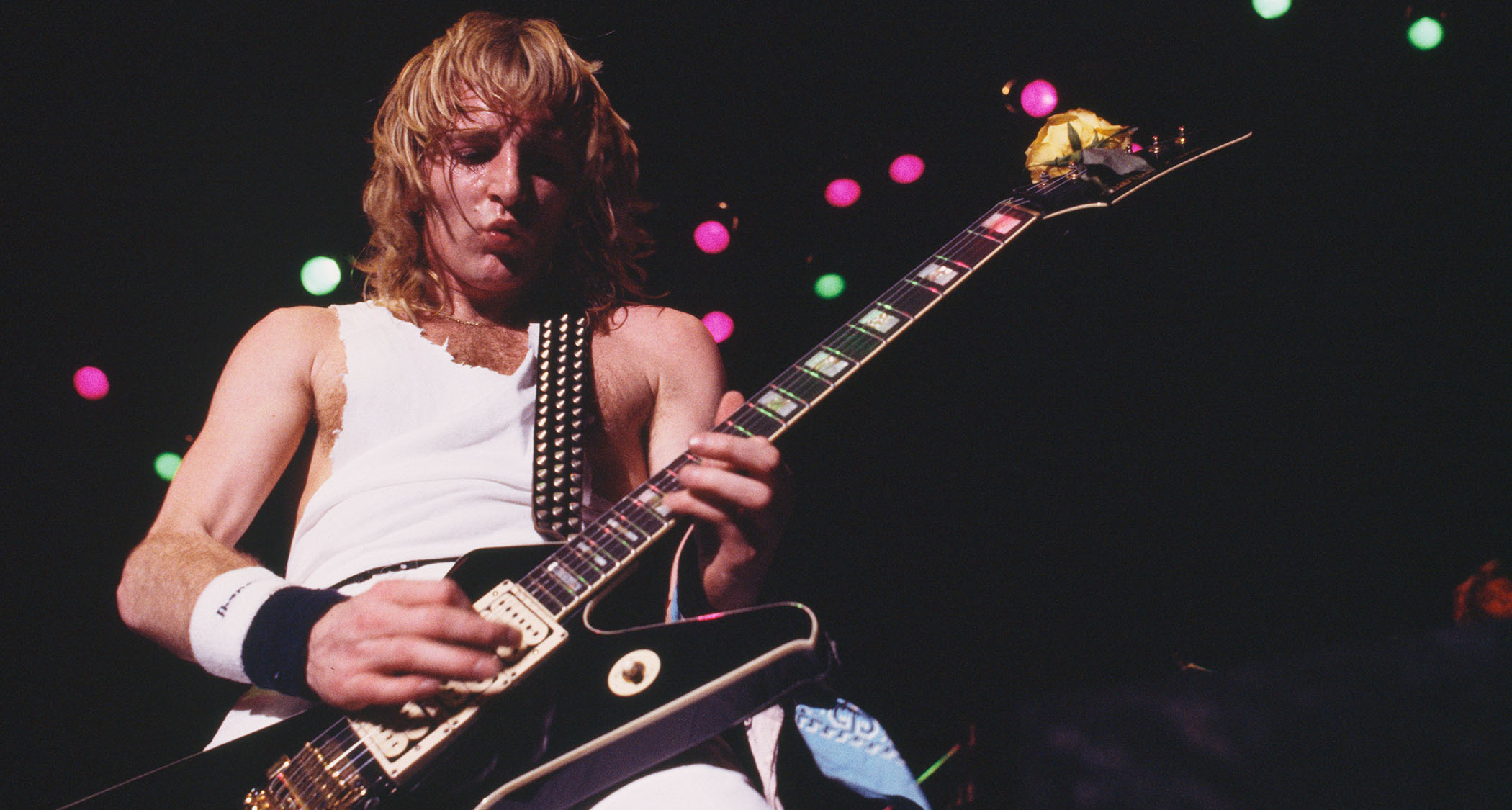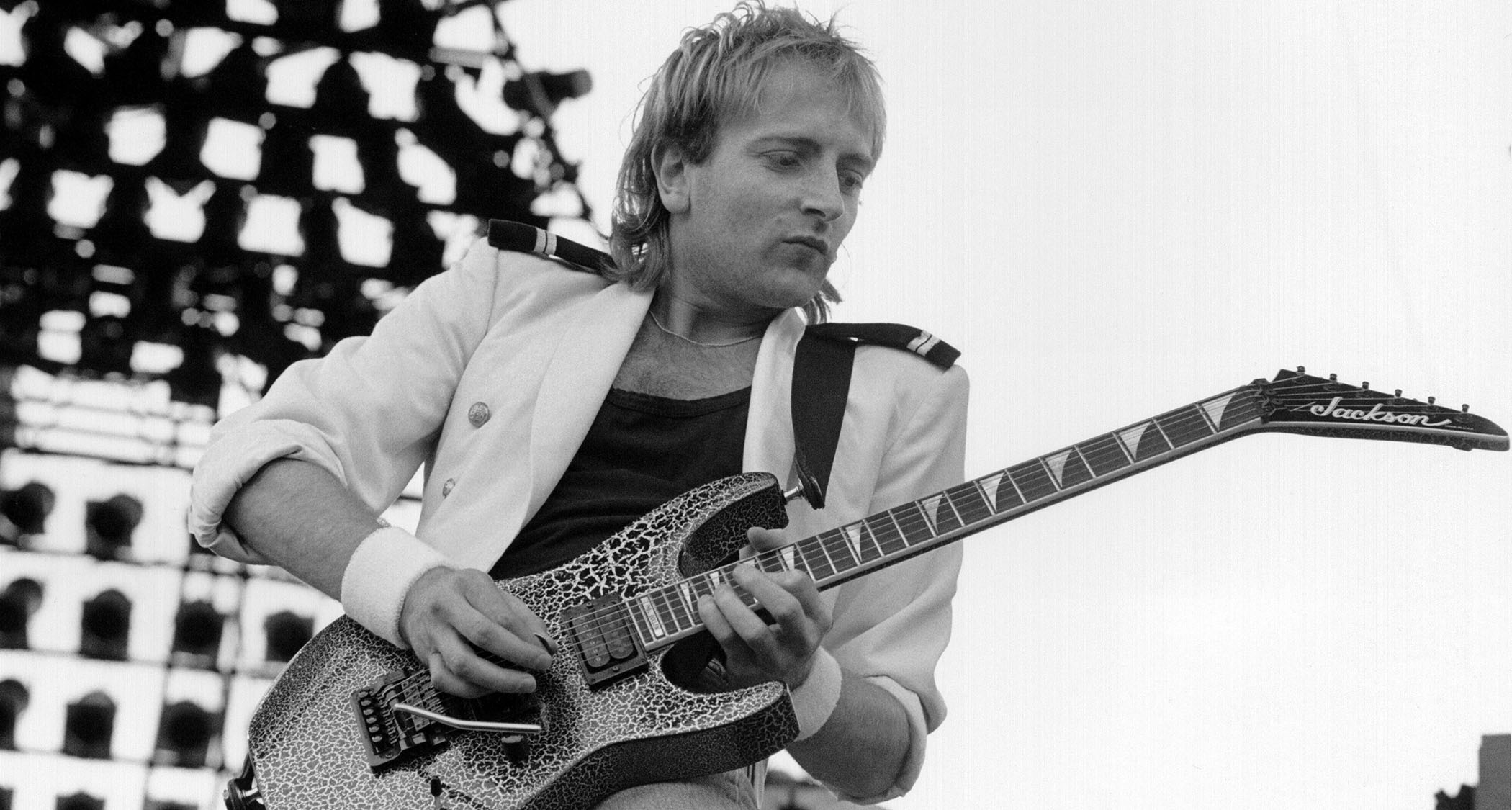“I thought I’d make the notes count, like Jeff Beck. It doesn’t sound anything like Jeff, but that was the intention going in!” Phil Collen on how – by accident and design – Def Leppard reinvented rock guitar on classic album Pyromania
Pyromania is 40 years young this year is still fresh as a daisy. Collen explains how tones, solos, Mutt Lange and the art of recording one string at a time forged a pivotal moment in rock

Every guitarist has been told that rhythm guitar is the most important skill, because no one gets a gig playing only solos. But when Phil Collen got the call to play on Def Leppard’s third album Pyromania, it was to do exactly that. “The painting was finished,” he recalls now. “I just threw an extra layer over it.”
The band’s first two albums had been recorded with the guitar team of Pete Willis and Steve Clark, but when Willis was dramatically fired late in the Pyromania sessions, Phil was drafted to provide the solos on songs that would become hit singles and deathless rock anthems: Photograph, Rock Of Ages, and Foolin’. It was the gig of a lifetime.
Pete Willis made a huge contribution to Pyromania, co-writing four of the songs and laying down rhythm parts that singer Joe Elliott called “phenomenal”. Producer Mutt Lange had relied on Willis for his Malcolm Young-like ability to play on the beat. But on a personal level, there was a disconnect between Willis and the rest of the band. Phil Collen, of London glam rock band Girl, was the perfect replacement.
When Leppard began work on Pyromania in 1982, the sound of the decade was still emerging. There were benchmarks – Van Halen, Boston and AC/DC – but no one had yet made the record to define rock in the ’80s.
Despite their relatively modest success to date, Leppard fancied their chances. In their corner they had Lange, still hot from AC/DC’s Back In Black, plus a pile of new technology no rock band had yet exploited, and a shitload of confidence.
As it turned out, that confidence was warranted. Released in January 1983, Pyromania went platinum in the US within three months, en route to 10 million sales. In its wake, record companies scrambled to sign bands aping the Pyromania formula of AC/DC’s crunch, Journey’s melody and Queen’s harmonies.
Leppard and Mutt Lange had cleverly employed synths and drum machines to make Pyromania larger-than-life without softening its attack or masking the guitars. While bands fought to match Leppard’s big riffs and bigger hooks, their producers struggled to replicate Lange’s jaw-dropping sonics.
Get The Pick Newsletter
All the latest guitar news, interviews, lessons, reviews, deals and more, direct to your inbox!
As a 40th anniversary deluxe edition of Pyromania is released this month – albeit a year late – Phil Collen looks back on the making of a masterpiece and his role in it…
Getting the tones
“We had hundreds of amps and cabinets in that studio, from AC/DC amps to little combos. Everything you could think of
To record their orchestrated guitars, Leppard needed a guitar tone that would play nicely alongside the synths and vocal harmonies. Engineer Mike Shipley, who died in 2013, described the nightmare of this process: “Because of the nature of the way that band played, and the inversions they used, it was very hard to get the right tone, what Mutt had in his head as ‘commercial distortion.’
“We had hundreds of amps and cabinets in that studio, from AC/DC amps to little combos. Everything you could think of. After a while you get so fatigued that nothing ever sounds good enough.”
The main Pyromania amp was a 100-watt Marshall head borrowed from session guitarist Mike Slamer, whose band City Boy had a minor hit with the Lange-produced 5-7-0-5.
“Now you could get the sounds that they were trying to get with stuff like Fractals,” Phil says. “Back then it was it wasn’t so easy. Those Marshalls would be so different from each other. You’d have to add things to an amp or get it modded, but occasionally you’d just get a beauty that for whatever reason just sings.”
Phil thinks Slamer’s amp was probably unmodified. “They just plugged it in and were like, ‘Oh, this has a different thing.’”
Phil wanted his own tone for the solos, so he brought his amp, a non-master volume Marshall JMP he’d bought in 1979 or 1980. “They’d spent months mic’ing this cabinet up. We literally just plugged my 50-watt Marshall in and it sounded great. It was a very different sound to what they’d been using.”
The one-take solo
For the fast run on Stagefright, I click it over to the neck pickup. That was the Al Di Meola influence... he would just get a smoothness that would just glide
The band gave Phil a tape with a rough mix of the song Stagefright. For his Def Leppard audition, Phil had to write a solo for it. He composed his solo overnight and recorded it in one take the next day.
“It was all my Ibanez Destroyer on that one,” he says. “It started on the bridge pickup. For the fast run, I click it over to the neck pickup. That was the Al Di Meola influence, because he would kick it into the neck pick up and just get a smoothness that would just glide.”
The remaining solos were worked out in the control room, with Phil improvising a take and Mutt Lange making suggestions for changes. Collen also played various overdubs. “It was mostly ‘vibe’ parts,” he says. “Root note things, powerchords and stuff. Little bits of solo stuff.”
Phil used three guitars: a black Japanese Stratocaster with a big headstock that would become the main guitar on the band’s next album Hysteria, the wine red Les Paul Custom he had used with his last band Girl, and the black Ibanez Destroyer that is synonymous with early Leppard thanks to its use in the Pyromania videos. The studio also had various Strats and Teles used for overdubbing, as well as Steve Clark’s Les Pauls.
In the end, Phil played solos on half the tracks, with Clark supplying the remainder. Each guitarist had a distinct role in the recording process.
“Pete had done a lot of the really very concise, strict rhythm,” Phil explains. “He was a really good player for that kind of stuff. And then Steve would do all the jangles over the top of it. I’d just come in and mess it all up with leads and powerchords, scrapes and feedback!”
Bassist Rick Savage also played clean guitar overdubs. “Sav’s really good at getting a very precise, clean jangle,” Phil says.
The solo that talks
I think you can really mess up a song by doing the wrong guitar solo. You follow the narrative that comes from the vocal and the lyric
For the solo in Rock Of Ages, Phil tried to emulate one of his heroes. "I thought I’d make the notes count, like Jeff Beck,” he says. “It doesn’t sound anything like Jeff, but that was the intention going in. You could hang on the note a little bit longer, and it would actually talk to you.”
The lick that opens the solo is a conscious quote from the “I’m burnin’, burnin’” vocal melody in verse two.
“The solos were worked out with the vocal in mind and the rhythm of the song,” he says. “I think you can really mess up a song by doing the wrong guitar solo. You follow the narrative that comes from the vocal and the lyric.”
The Johnny Thunders vibe
Phil’s solo on Rock! Rock! (Till You Drop) has a noticeably cleaner tone than the other solos, all of which came from the Ibanez Destroyer. He used the same amp settings for everything, though.
“For Rock! Rock!, I used the Les Paul. It just definitely has a cleaner sound,” Phil says, even though all his guitars were fitted with the same DiMarzio Super Distortion pickups. Although the solo begins with a Chuck Berry lick beloved by Eddie Van Halen and Angus Young, Phil didn’t actually have any of those players in mind.
“I was thinking more in the tradition of Johnny Thunders. There’s a punkiness. I love Angus and Eddie, but we always try and get the Johnny Thunders vibe in because it’s a bit more aggressive and violent.
“For the ride-out solo, there was a Hamer guitar just sitting around. I don’t know what model it was or who it belonged to. I remember picking that up, and that’s what I used.”
Recording one string at a time
People say, ‘Oh Def Leppard record one string at a time!’ Yeah, we did that, but only when you want to get clarity. Usually it was just two strings, and then you mix that in with the distorted riff
In an interview with Leppard biographer David Fricke, Mutt Lange explained how the Pyromania guitar tones were created. Referring to the album’s final track Billy’s Got A Gun, Lange said:
“That big orchestral riff is in C, which is a really ball-less key. But the riff only sounded good in C, so we couldn’t move it. In order to get a good, cutting sound and still keep the bottom end nice and fat, we had to work on the sound in stages.
“We’d get a powerful sound with a lot of attack on one string. Then we’d set up a clean harmony on a lower one. After that, we could cut the exact same riff on those strings with a more honky sound to get a solid mid-range. Then we’d do the same riff a third time to get a real booming sound down below. That would be one guitar, three weeks later!”
As Phil now explains: “People say, ‘Oh Def Leppard record one string at a time!’ Yeah, we did that, but only when you want to get clarity. On Too Late For Love, that middle riff section, a lot of the distortion would fuzz up some of the clarity of the notes. Mutt would say, ‘Let’s separate the riff.’ Usually it was just two parts, two strings, and then you mix that in with the distorted riff.”
This approach meant you could hear the individual notes even in complex chords, but as Phil says: “It still has that rock energy.”
Jangle and feedback
The arpeggiated chorus in Photograph had been recorded with the cleanest possible guitar tone. “The jangle part is country clean,” Phil says. “It’s actually a Stratocaster, and it’s just so clean. It need something to bolster it up so it just didn’t sound too country.”
Mutt suggested Phil overdub the root note of each arpeggio with a dirty tone. “It was probably a Boss pedal. It was just the root note with a with a kind of a fuzzy sound.” In context, a sonic miracle occurs: the fuzzed-out root notes and the clean arpeggios merge into one clean-yet-dirty tone.

For the solo, Phil wanted to create a dramatic entrance with feedback, so he stood next to his amp in the live room. “I always want to do feedback bits on songs. I always loved the way Mick Ronson hit the root note and it turns into feedback. It’s one of my favourite things.”
The last-minute panic
The first time I heard it I thought it was the best rock album I’d ever heard in my life. I remember it like it was yesterday
The band and their producer had headed into the sessions knowing they wanted to make an album that had never been done before. It turned out they very nearly couldn’t. For one thing, their ears were fried.
“We were singing a semitone sharp,” Mutt said. “Our ears would get tired and we couldn’t hear the bass anymore. We watched Elton John on Top Of The Pops one night and he sounded really out of tune.”
Rick Savage’s bass parts had been recorded first, and where his tuning had drifted, the guitars had to be retuned to match. When it came time to record backing vocals, the band were horrified to discover some of the guitars were also out of tune.
There was no time to recut them, so engineer Mike Shipley put them through a harmoniser, whose chorusing effect masked the tuning errors. The popularity of harmonised guitars for the rest of the decade was partly inspired by this happy accident.
To make things worse, technology began to fail them. In recording so many overdubs, the multitrack tapes had been rewound so many times that the oxide began falling off in two-inch chunks, leaving the tape almost see-through and robbing the guitar tracks of some of their original high end.
The drums and other samples were run on the Fairlight CMI, an early digital sampler and sequencer, which somehow had to be kept in sync with the analogue recordings. By the time they reached the mix stage, Mike Shipley had fallen asleep at the desk twice, and Lange had to finish the sessions with assistance from Nigel Green (who would later fall asleep at the desk during the making of Hysteria).
Feel the burn!
By the time Pyromania was completed, the band needed to sell a million copies to break even. Neither of their first two albums had shifted even half that amount. But they needn’t have worried. Photograph was an immediate smash on radio and MTV, and the album was soon selling 100,000 copies per week.
As well as changing the sound of the ’80s, Pyromania has had a long-lasting influence. As System Of A Down’s Daron Malakion told VH-1, “Pyromania was a big part of our childhood so it has to play some kind of role in our music.”
In 2008, Taylor Swift performed a Crossroads concert with Def Leppard, duetting with Joe Elliott on Photograph and a selection of other Leppard and Swift hits.
And after all these years, Phil Collen still can’t believe his luck. “It’s crazy,” he laughs. “The first time I heard it I thought it was the best rock album I’d ever heard in my life. I remember it like it was yesterday.”
- Pyromania 40th Anniversary Edition is out now via Island Records.
Jenna writes for Total Guitar and Guitar World, and is the former classic rock columnist for Guitar Techniques. She studied with Guthrie Govan at BIMM, and has taught guitar for 15 years. She's toured in 10 countries and played on a Top 10 album (in Sweden).
“The main acoustic is a $100 Fender – the strings were super-old and dusty. We hate new strings!” Meet Great Grandpa, the unpredictable indie rockers making epic anthems with cheap acoustics – and recording guitars like a Queens of the Stone Age drummer
“You can almost hear the music in your head when looking at these photos”: How legendary photographer Jim Marshall captured the essence of the Grateful Dead and documented the rise of the ultimate jam band


![John Mayer and Bob Weir [left] of Dead & Company photographed against a grey background. Mayer wears a blue overshirt and has his signature Silver Sky on his shoulder. Weir wears grey and a bolo tie.](https://cdn.mos.cms.futurecdn.net/C6niSAybzVCHoYcpJ8ZZgE.jpg)

![A black-and-white action shot of Sergeant Thunderhoof perform live: [from left] Mark Sayer, Dan Flitcroft, Jim Camp and Josh Gallop](https://cdn.mos.cms.futurecdn.net/am3UhJbsxAE239XRRZ8zC8.jpg)






